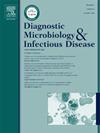Burden of acute hepatitis E virus in South Asia: Insights from Global Burden of Disease study 2021
IF 2.1
4区 医学
Q3 INFECTIOUS DISEASES
Diagnostic microbiology and infectious disease
Pub Date : 2025-03-08
DOI:10.1016/j.diagmicrobio.2025.116767
引用次数: 0
Abstract
Background
Despite global progress, South Asian countries account for a disproportionate burden of Acute hepatitis E (AHE). Understanding the burden of AHE in this region is crucial for targeted interventions.
Methods
We used Global Burden of Disease (GBD) 2021 data to assess the burden of AHE across eight South Asian countries from 1990 to 2021. Joinpoint regression was used to analyze temporal trends and Estimated Annual Percentage Change (EAPC) was calculated to quantify trends. The relationship between age-standardized disability-adjusted life years rate (ASDR) and socio-demographic index (SDI) was assessed using smoothing spline model and Spearman rank correlation. Rates are expressed per 100,000 population.
Results
Bangladesh had highest age-standardized prevalence rate (ASPR) [33.27 (95 % Uncertainty Interval: 27.64 to 39.95)] and age-standardized incidence rate (ASIR) [433.01 (359.61 to 519.76)], while India had highest ASDR [9.52 (4.33 to 18.42)]. Males had higher ASIR and ASPR than females in most South Asian countries, except Bhutan and India, and higher ASDR except in Nepal and Pakistan. Bhutan had the highest EAPC for both sexes in ASPR and ASIR, while India had the highest EAPC in ASDR, closely followed by Bhutan for both sexes. Age group 5-9 had the highest ASPR and ASIR whereas <1-year age group had the highest ASDR. There was an inverse relationship between ASDR and SDI (R = -0.49, p < 0.01).
Conclusion
South Asia bears a high burden of AHE, with variations across countries. Improvements in Water Sanitation and Hygiene (WASH) services are needed to achieve Sustainable Development Goals 3 and 6.
南亚急性戊型肝炎病毒负担:来自2021年全球疾病负担研究的见解
尽管全球取得了进展,但南亚国家仍占急性戊型肝炎(AHE)负担的不成比例。了解该地区AHE的负担对于有针对性的干预措施至关重要。方法使用全球疾病负担(GBD) 2021数据评估1990年至2021年8个南亚国家的AHE负担。采用联合点回归分析时间趋势,并计算估计年百分比变化(EAPC)来量化趋势。采用平滑样条模型和Spearman秩相关评估年龄标准化残疾调整生命年率(ASDR)与社会人口指数(SDI)的关系。比率以每10万人表示。结果孟加拉国的年龄标准化患病率(ASPR)和年龄标准化发病率(ASIR)最高,分别为33.27(95%不确定区间:27.64 ~ 39.95)和433.01(359.61 ~ 519.76),印度的ASDR最高,分别为9.52(4.33 ~ 18.42)。除不丹和印度外,大多数南亚国家男性的ASIR和ASPR高于女性,除尼泊尔和巴基斯坦外,男性的ASDR高于女性。不丹在ASPR和ASIR方面的男女EAPC最高,而印度在ASDR方面的EAPC最高,紧随其后的是不丹。5 ~ 9岁儿童ASDR和ASIR最高,1岁儿童ASDR最高。ASDR与SDI呈负相关(R = -0.49, p <;0.01)。结论南亚地区AHE发病率较高,且各国存在差异。要实现可持续发展目标3和6,就需要改善水环境卫生和个人卫生服务。
本文章由计算机程序翻译,如有差异,请以英文原文为准。
求助全文
约1分钟内获得全文
求助全文
来源期刊
CiteScore
5.30
自引率
3.40%
发文量
149
审稿时长
56 days
期刊介绍:
Diagnostic Microbiology and Infectious Disease keeps you informed of the latest developments in clinical microbiology and the diagnosis and treatment of infectious diseases. Packed with rigorously peer-reviewed articles and studies in bacteriology, immunology, immunoserology, infectious diseases, mycology, parasitology, and virology, the journal examines new procedures, unusual cases, controversial issues, and important new literature. Diagnostic Microbiology and Infectious Disease distinguished independent editorial board, consisting of experts from many medical specialties, ensures you extensive and authoritative coverage.

 求助内容:
求助内容: 应助结果提醒方式:
应助结果提醒方式:


